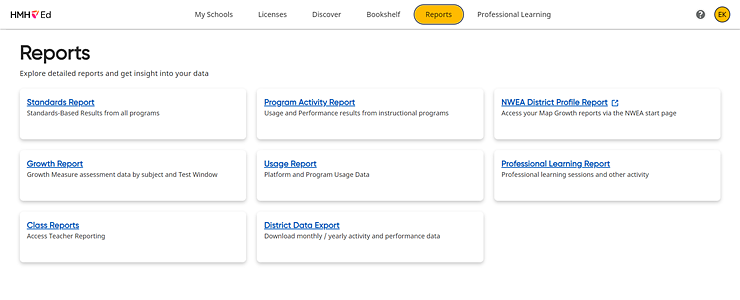
The District Standards Reports show performance based on standards in the selected subject for the school year period starting July 1 to the current date. This report helps administrators analyze domain performance and standard performance.
School and district administrators have access to the Standards Report that combines program assessment and Growth Measure results to provide a comprehensive set of student data through the lens of a selected standard set, which can be the state standards or Common Core National standards. The report rolls-up data from every student into classes, across schools, and to an overall district average for each domain. Administrators can drill into standards and back down into schools, classes, and even students.
Note: Accessing data in active classes prior to July 1 can be achieved by customizing the date range using the Customize This Report option. (Details provided below.)
Administrators can customize their Standards Report and then generate two CSV files (Domain Summary and Standard Details) based on the selected criteria.
1. In the banner, click the Reports tab, and on the Reports page, click the Standards Report card.

The report page takes a few moments to load the report filters with your district data.

2. From the lists provided, select the Subject, Standard Set, and Standard Grade Level (grade level of the standard set to be analyzed).
Note: The Class Grade defaults to match the Standard Grade Level, but you can select to include All Grades or other class grade levels.
The report page updates to display the domains for the selected subject and grade. The scatter plot graphs show each school’s average for that domain in comparison to the district overall average. The school averages per domain are then grouped into the associated performance levels.
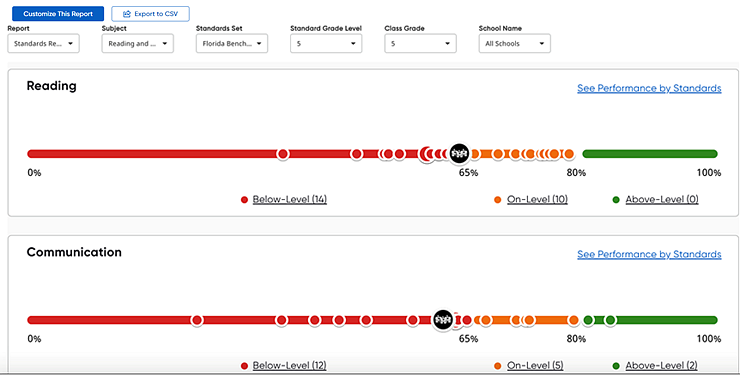
Note the following details about the Standards Report:
– Each standard set consists of multiple domains, which are listed in individual cards on the Standards Report page. However, only domains for which data exists are displayed.
– For
each domain, a scatter plot shows the average proficiency score of the
district, represented by a large black and white node ![]() with the image of several buildings. The average scores of each school
in the district is represented on the graph by an individual node displayed
in color-coded ranges.
with the image of several buildings. The average scores of each school
in the district is represented on the graph by an individual node displayed
in color-coded ranges.
– A school's average proficiency score for each domain is calculated based on all the assessment items (across all assessments) the school has taken that are assessing standards within that particular domain.
– If a school has no data for a domain, then that school does not appear on the graphs or lists.
3. On the district-level Standards Report page, do any of the following:
Action |
Steps |
Customize the report |
a.
b. In the lists provided, select options by which to customize the report: Program, Assessment Type(s), and Period.
– The report defaults to show all grade levels where data exists in a standard set (Common Core, VASOL, TEKS, BEST, and so on). In many instances, the student data from a class covers multiple grade levels. The reasons for this can be any of the following:
○ The Growth Measure covers at least one grade level above, on grade level, and at a minimum two grade levels below the actual grade level of the test.
○ Many Into Math and Reading classrooms have multiple grade levels of the curriculum available to them in their classrooms.
○ Math 180’s mSkills assessments may also cover more than one grade level of standards.
In most state and national standards sets, the domains are often the same across multiple grade levels making it hard to determine which grade level of the standards is being shown. To focus on the grade level standards in which you are most interested, you can customize the report to a specific Standard Set and Grade Level. This grade level is noted on each domain within the report.
– The Program list defaults to All Programs for the selected subject. If available, specific programs are listed (Into Math, Growth Measure, Math 180, Into Literature, Read 180, Into Reading, and so on), allowing a more granular view into student performance on the specific program.
– Assessment Type(s) defaults to All Types (Interactive Weekly, Module Assessments, and so on). The list of assessments varies, depending on the selected program and subject; for example, Waggle ELA (for Reading and Language Arts) and Waggle Math offer Practice as an assessment type, which allows you to isolate Waggle Practice as the only standards-based data in the report.
c. Click Apply. The Standards Report updates to reflect your newly selected report options. |
View an individual school's scores |
➔ From the Schools list, select a school for which to view the standards report. The Standard Report page updates to display the report for the selected school. |
View school scores within graphs |
➔ For each domain, click a color band link (below the graph) to view the list of schools whose scores fall within that score range.
|
View the Domain Performance by Standard |
➔ In the upper
right corner of each domain card, click the A Domain Performance by Standard page appears listing the detailed standards that make up the selected domain.
Note the following details about the Domain Performance by Standard page: – All the detailed standards of the selected domain are listed as individual cards. However, only standards for which data exists are displayed. – For
each detailed standard, a scatter plot shows the average proficiency
score of the district, represented by a large black and white
node |
4. On the Domain Performance by Standard page, do any of the following:
– In
the upper right corner of a detailed standard card, click the  link to view the resources that
are aligned to this standard. The Resources
page appears, filtered to a list of resources aligned to this standard
and combined with resources from all programs available in the district.
You can select a program on this Resources page to further refine the
available aligned resources.
link to view the resources that
are aligned to this standard. The Resources
page appears, filtered to a list of resources aligned to this standard
and combined with resources from all programs available in the district.
You can select a program on this Resources page to further refine the
available aligned resources.
– In any detailed standard card, click a color band link (below the graph) to view the list of schools whose scores fall within that score range.

– Within the list of schools, click the View link to view the Standards Report for that school.
Note that on each scatter plot, the selected school's
average score is represented by the school ![]() icon, and for each domain card, you can click a color band to view the
list of the classes that have scores
within that range.
icon, and for each domain card, you can click a color band to view the
list of the classes that have scores
within that range.
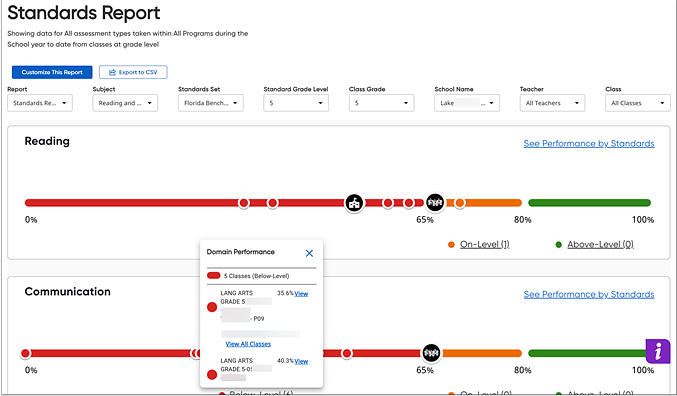
– Within
the dialog box, click the View
link to see the report for a specific class.
Note that on each scatter plot, the average score of the selected class is
represented by the class ![]() icon,
and the scores for each student are represented by individual dots.
icon,
and the scores for each student are represented by individual dots.
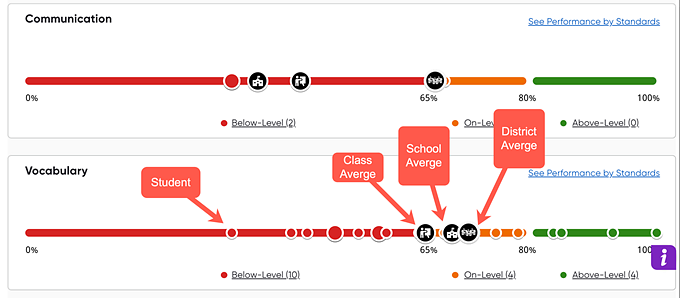
– Click the Back link at the top of the page to return to the cumulative Standards Report page.
5. To export CSV files based on the selections you made, click the Export to CSV button at the top of the page, and then follow your browser's prompts to open or save the CSV export files.
Two CSV files are created—a Domain Summary file and a Standard Details file, as detailed below.
– The Domain Summary CSV file displays the data shown on the Domain report page; the file name is “Admin Standard Report - Domain Summary [Date Stamp].”

– The Standard Details CSV file captures the data on the See Performance by Standards links; the file name is “Admin Standard Report - Standard Details [Date stamp]."
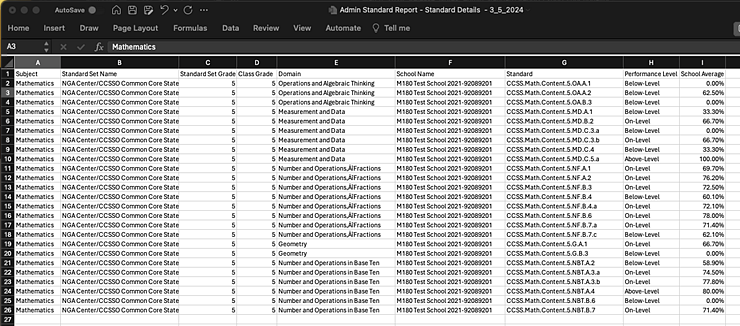
See also: